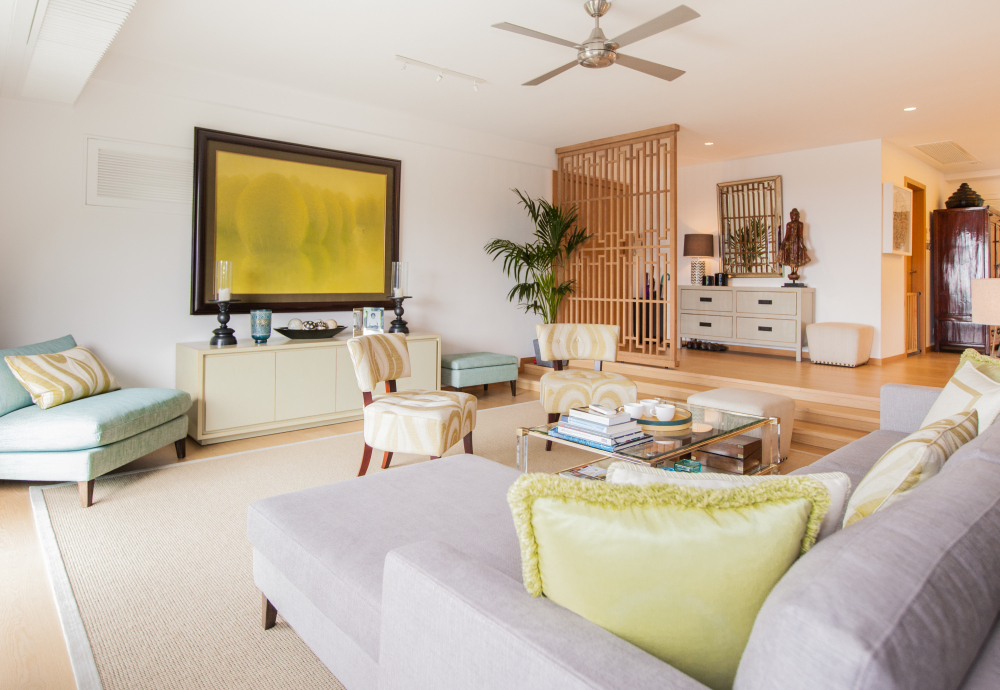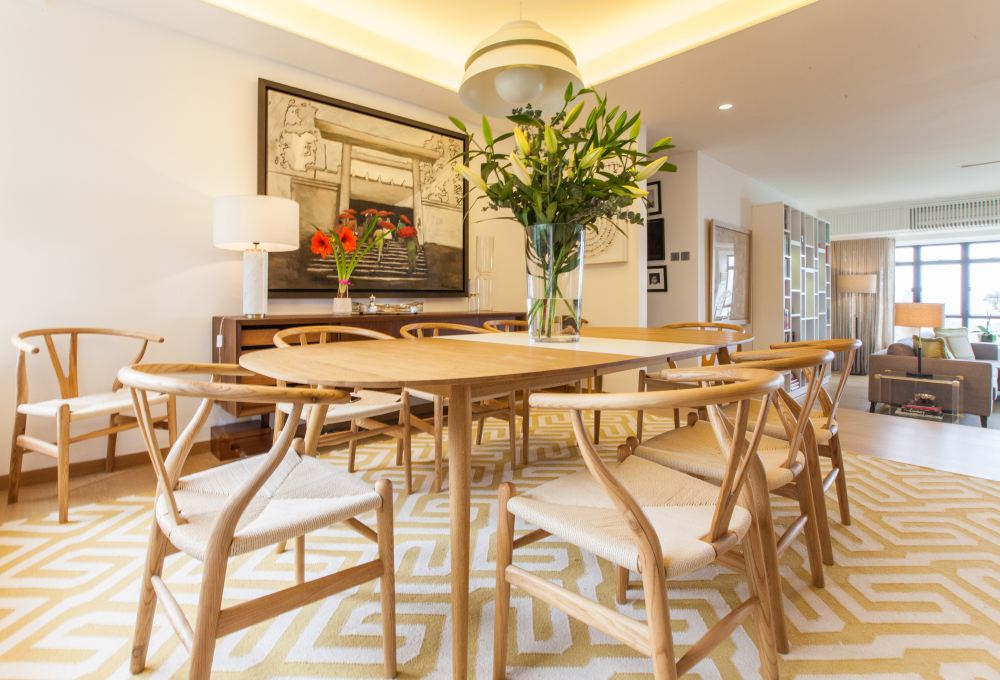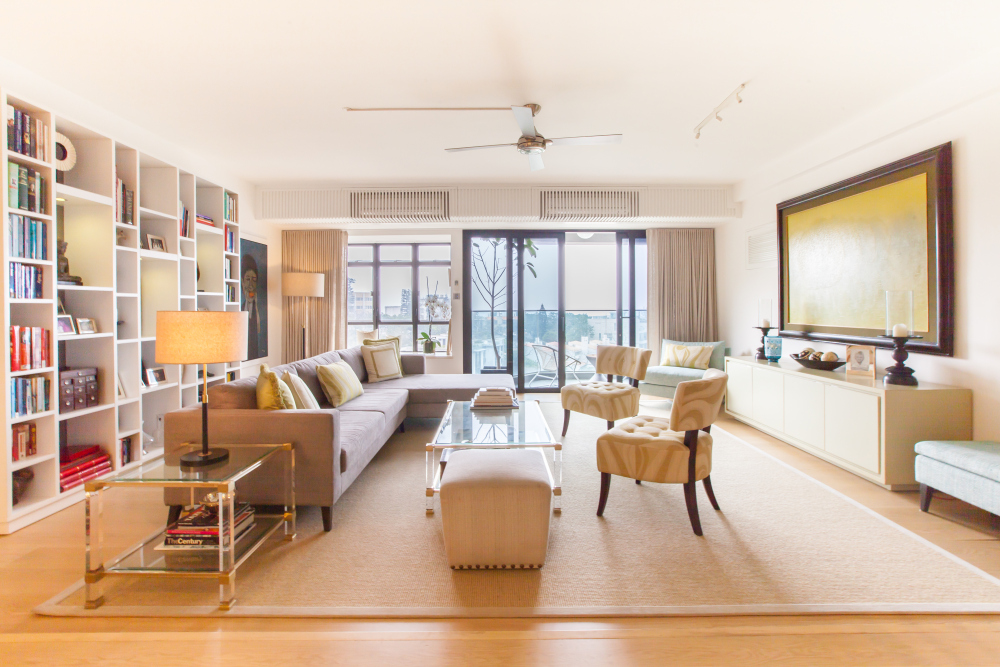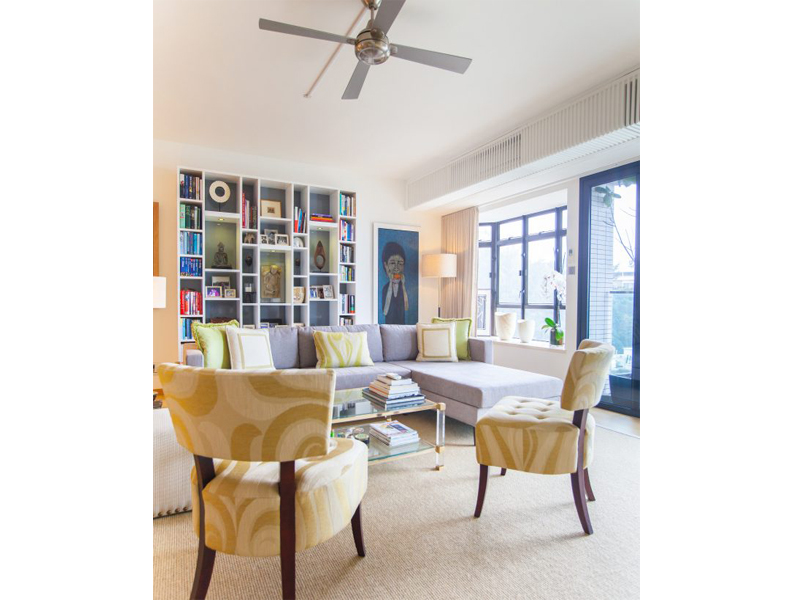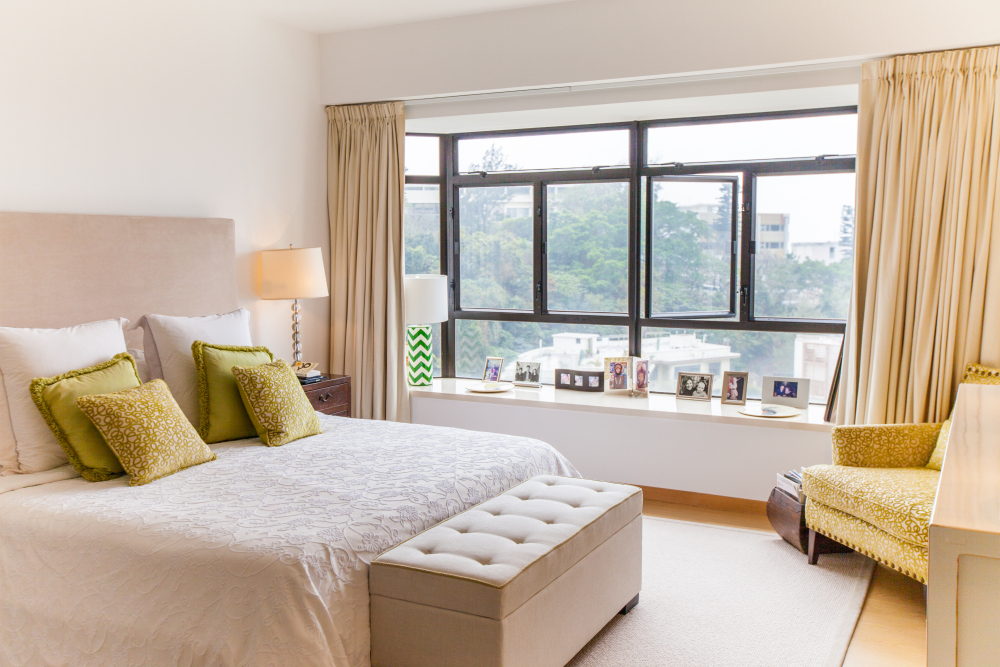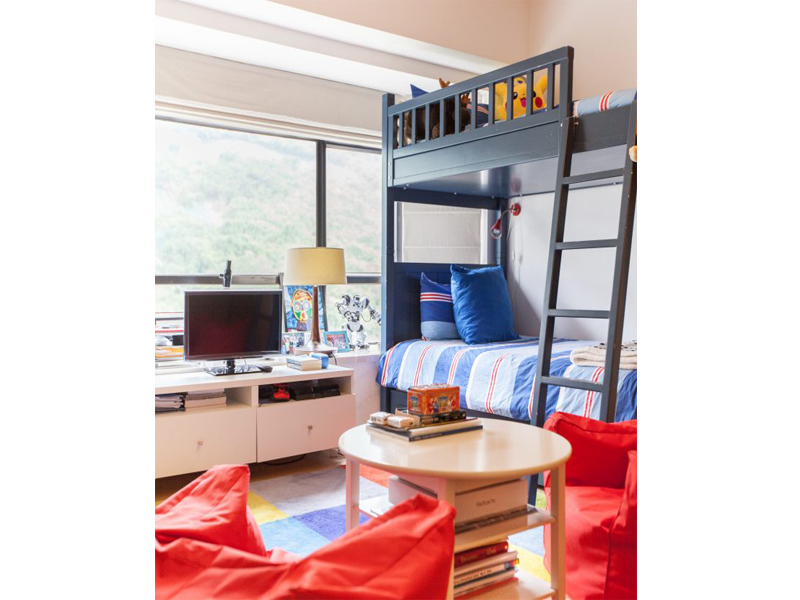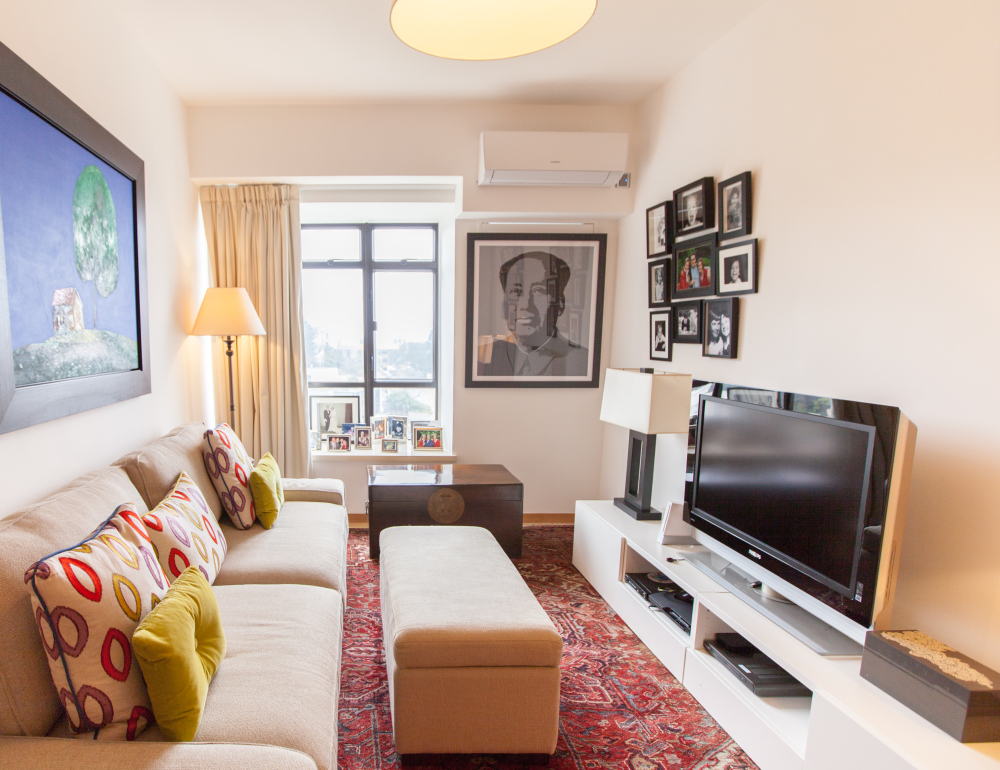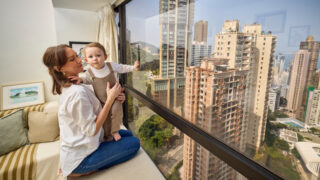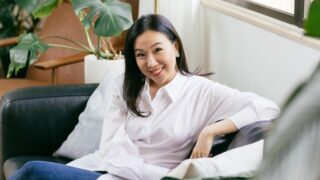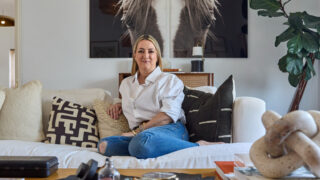Interior designer Emma Hurlston-Tseng shares the secrets behind the serene South Bay apartment she has created for Libby Vaughan, founder of the Cambodian Children’s Fund Hong Kong (CCF).
You’ve created such a tranquil oasis out of a standard Hong Kong apartment. How easy is it to turn a rented space into a proper home?
There’s so much you can do to make your rented space feel unique, homelike and personal to you. Your first task is to think about the mood and feel you want to evoke. Libby had previously lived in a house with dark parquet floors, and a great deal of dark wood furniture. She wanted to move to something lighter and airier, in tune with this sea-view apartment, where space flowed more freely. She loves green, and so we built the colour scheme around a peaceful palette of sage, moss, lime, soft blue, grey and cream, echoing the hues in her artworks, and using the fabric from a couple of existing chairs as a reference. The finished apartment has a very soothing, relaxing feel.
What are some other considerations to keep in mind?
It’s important to think carefully about how you’re going to use the space. Besides needing a more open-style floor plan for her growing boys, Libby loves entertaining at home. She wanted a flexible cocktail space because she generally serves canapés rather than a sit-down starter, so we created a spacious area with seating that was easy to move around, and found a dining table with an extra pop-up leaf that will easily seat 10. A good designer will often ask detailed questions about the way a client uses their home: usually, people haven’t articulated it even to themselves! I designed and installed a wooden screen to divide the entrance hall from the living area, which immediately gave the room a different feel. As well as creating a separate zone, the contemporary take on the Chinese trellis design echoes the geometric pattern of the carpet, helping the eye travel around the space. We weren’t allowed to drill into the floor, so the screen is tension-mounted to fix it securely to the ceiling and wall. We were also forbidden to paint the walls, but I wanted to introduce more colour into the living space, so we commissioned a large, sculptural bookcase for behind the sofa. The soft grey panels at the back are lacquered to reflect the light and give a bit of shine, and hidden lighting showcases the books, ornaments and treasures Libby’s collected from around the world, and provides a touch of drama. And what about the choice of furniture? Being able to commission furniture that is exactly right for the space is one of the obvious advantages of working with an interior designer. I have a contact list of reliable manufacturers and craftsmen who I know will produce quality pieces. Hong Kong is such a small place, people often end up having the same things, and I wanted to make sure this space was uniquely personal and sophisticated.
As an interior designer with a background in fashion, what tips do you have for bringing a room up to date?
It’s true the fashion and interiors worlds are the closest they’ve ever been, with catwalk trends greatly influencing furniture and textiles, but I would caution against slavishly following fashion, unless you want your design to very quickly date! If you fall in love with the colour du jour – a Klein blue perhaps – consider using it for cushions or accessories, rather than committing to a large piece of furniture like a sofa. It can be fabulously impactful, but again, carefully consider the mood and feel you prefer: strong, bright colours do not always make for a peaceful environment. Take where you live into account. Personally, I love the look and feel of velvet; those rich, jewel colours are so on trend at the moment. They are especially fabulous combined with dark painted walls, but that particular look is much more suited to a cold climate. If you’re renovating or changing your décor during December and January, think about the rest of the year in Hong Kong when the weather is light, airy and warm for much of the time. Similarly, some fabric trends just don’t translate well into our humid climate. One of the current fashions is for long shaggy furs dyed different colours. I’ve got a gorgeous pale pink shaggy cushion, but I’ll be putting it away as soon as the weather starts heating up. It gets to the point where you feel hot just looking at it!
Tell us a bit about the layered approach that you like to adopt.
Rather than fill a room with a host of modish, contemporary furniture and accessories, consider mixing different looks and eras. In Libby’s flat, for example, we combined mid-century in the dining area with classic contemporary and vintage glamour in the living room. We commissioned and upholstered a sofa in beautiful European linen and bought the pared-back Danish dining table from Rimba Rhyme, but I also found these gorgeous Lucite and brass coffee tables from an antique dealer in the UK. They’re French (Pierre Vandal circa 1970s) and I loved how the brass trim wasn’t new and shiny – the current trend for harsh, shiny metals will inevitably date – but had a very mellow patina. I also adore the feeling and sense of journey behind vintage pieces, and it’s interesting to mix them into a space, especially an ostensibly contemporary one.
Plants can play a role too, right?
Yes – another current trend that’s easy to adopt is the 1970s vogue for houseplants. Libby needed a desk that would fit seamlessly into a bedroom environment, so I sourced this shagreen (sharkskin) piece from Indigo, and teamed it with a slubby linen-covered chair in moss green, for an extra punch of colour. It looks like a piece of comfortable bedroom furniture, but it’s actually very firm and supportive. Plants can play a role too, right? Yes – another current trend that’s easy to adopt is the 1970s vogue for houseplants. Libby was hesitant about wholly buying into the seventies cheese plant trend, so instead we’ve put a Kentia Palm next to the entrance screen. Aside from that all-important layered feel, it adds the missing pop of dark green amongst the other tones in the room, and enhances interest with its negative space and shadows.
Emma’s Recommendations:
Rimba Rhyme
5/F, Horizon Plaza 2 Lee Wing Street, Ap Lei Chau
Indigo
6/F, Horizon Plaza 2 Lee Wing Street, Ap Lei Chau
Casacapriz
1/F, Kwai Bo Industrial Building 40 Wong Chuk Hang Road, Aberdeen
Bricks & Stones
G/F, 97 Queen’s Road East, Wan Chai
Hayfever
G/F, 62-64 Flower Market Road Mong Kok
This article first appeared in the Aug/Sep 2016 edition of Expat Living magazine.
Get more interiors inspiration from our readers’ homes.

